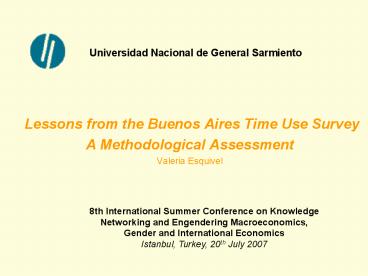Universidad Nacional de General Sarmiento - PowerPoint PPT Presentation
1 / 15
Title:
Universidad Nacional de General Sarmiento
Description:
The Buenos Aires Annual Household Survey is collected annually by the DGEyC. Multi-purpose household survey, representative of Buenos Aires population (8% of country) ... – PowerPoint PPT presentation
Number of Views:49
Avg rating:3.0/5.0
Title: Universidad Nacional de General Sarmiento
1
Universidad Nacional de General Sarmiento
- Lessons from the Buenos Aires Time Use Survey
- A Methodological Assessment
- Valeria Esquivel
8th International Summer Conference on Knowledge
Networking and Engendering Macroeconomics, Gender
and International Economics Istanbul, Turkey,
20th July 2007
2
The Latin American Experience in TUS data
collection
- A cumulative process of learning by doing since
first experiences took place (Cuba in 2001,
Mexico in 1996, Nicaragua in 1998). A new breed
of TUS comprising the 2006 Ecuadorian TUS, the
2003 Uruguayan TUS and the 2005 Buenos Aires TUS. - Different approaches to TUS according to
objectives and budgetary restrictions.
3
The Latin American Experience in TUS data
collection
- Strong advocacy for modular approaches, though
- There is an excessive emphasis in advocating for
tasks list surveys, even though their drawbacks
are clearly recognized - based almost exclusively on costs
considerations.
4
The BA TUS Institutional framework
- Local legislature mandate to collect time use
data on a regular bases to measure womens
contribution to the economy. - Cooperation agreement between Universidad
Nacional de General Sarmiento and the
Directorate-General of Statistics of the Buenos
Aires City Government.
5
The BA TUS as a module of AHS
- The Buenos Aires Annual Household Survey is
collected annually by the DGEyC. Multi-purpose
household survey, representative of Buenos Aires
population (8 of country). - Data on social and demographic variables
households and families dwellings health
education labor market status incomes social
policies. - The BA TUS was a module applied to 1/3 of total
surveyed households.
6
Main methodological features
- a. Survey type module attached to an ongoing
household survey - b. Data Collection Instrument Activity Diary
- The activity dairy started 4AM yesterday and
lasted till 4AM of the interview day. The diary
was a closed grid consisting on 48 30-minutes
long time slots that allowed for up to three
consecutive and/or simultaneous activities. Every
activity had a location mark.
7
Main methodological features
- c. Data Collection Method 24 hour recall
interview - This diary was filled in by interviewers (not
respondents) using a series of questions that
prompted respondents recall. - Respondents reported in their own words their
previous days activities, starting on their
waking up time and ending when the respondent
went to sleep. - A special set of questions was designed to ease
the reporting of paid working hours and at the
same time avoid missing simultaneous activities
performed while doing paid work.
8
Main methodological features
- d. Unit of analysis the individual
- Only one randomly selected household member,
either women or men between 15 and 74 years of
age answered to the diary. - The BA TUS respondent might coincide (or not)
with the core survey respondent. Like many other
multi-purpose household surveys, one adult
household member could answer the whole of the
Annual Household Survey, but this member might or
might not be chosen to answer to the time use
module.
9
Main methodological features
- e. Contextual variables
- Location codes.
- f. Probing questions
- Probing questions were added to check whether
some of the activities mentioned were done for
pay (thus helping post coding) and to capture
child care time which goes frequently
underreported. A question asking on whether the
day reported was typical was also added to act as
control.
10
Probing questions
11
Main methodological features
- g. Treatment of simultaneous activities
- Up to three non-hierarchical simultaneous
activities in each time slot
12
Main methodological features
- h. Activity Classification System
- Aggregation issues in relation to the ACS
(2-digit). - Only one SNA-work category was used (100, and
200 and 300 activities were not included), since
very few (if any) primary production for self
consumption takes place in the Buenos Aires City
urban context. - Caring for children activities and special
cases.
13
Activity Coding
- MANY ACTIONS CAN BE AN UNIQUE ACTIVITY,
REGISTERED ON A LINE
14
Activity Coding
- MANY ACTIVITIES COULD BE SUMMARIZED IN A SINGLE
ACTION
15
Some quality indicators
- 80 of interviews took 20 minutes or less.
- 68 of overlapping between AHS respondent and TUS
respondent. - Household member respondent highly correlated
with size and household type. - 10 non-response rate.
- 21 average episodes.
- 28.3 hours of avarage day when simultaneous
activities are fully accounted for.































